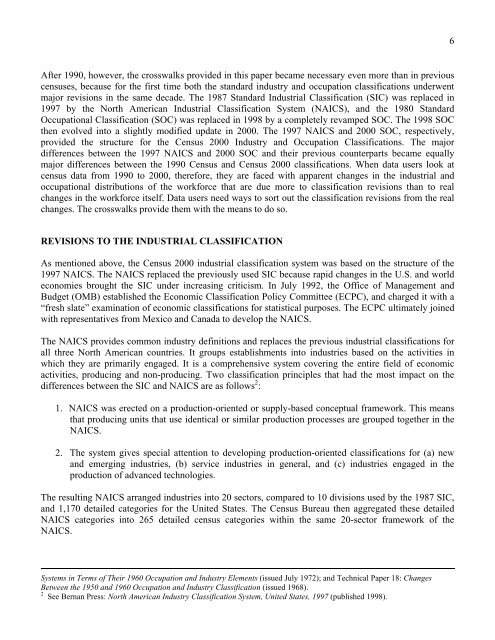The Relationship Between The 1990 Census and ... - Census Bureau
The Relationship Between The 1990 Census and ... - Census Bureau
The Relationship Between The 1990 Census and ... - Census Bureau
Create successful ePaper yourself
Turn your PDF publications into a flip-book with our unique Google optimized e-Paper software.
After <strong>1990</strong>, however, the crosswalks provided in this paper became necessary even more than in previous<br />
censuses, because for the first time both the st<strong>and</strong>ard industry <strong>and</strong> occupation classifications underwent<br />
major revisions in the same decade. <strong>The</strong> 1987 St<strong>and</strong>ard Industrial Classification (SIC) was replaced in<br />
1997 by the North American Industrial Classification System (NAICS), <strong>and</strong> the 1980 St<strong>and</strong>ard<br />
Occupational Classification (SOC) was replaced in 1998 by a completely revamped SOC. <strong>The</strong> 1998 SOC<br />
then evolved into a slightly modified update in 2000. <strong>The</strong> 1997 NAICS <strong>and</strong> 2000 SOC, respectively,<br />
provided the structure for the <strong>Census</strong> 2000 Industry <strong>and</strong> Occupation Classifications. <strong>The</strong> major<br />
differences between the 1997 NAICS <strong>and</strong> 2000 SOC <strong>and</strong> their previous counterparts became equally<br />
major differences between the <strong>1990</strong> <strong>Census</strong> <strong>and</strong> <strong>Census</strong> 2000 classifications. When data users look at<br />
census data from <strong>1990</strong> to 2000, therefore, they are faced with apparent changes in the industrial <strong>and</strong><br />
occupational distributions of the workforce that are due more to classification revisions than to real<br />
changes in the workforce itself. Data users need ways to sort out the classification revisions from the real<br />
changes. <strong>The</strong> crosswalks provide them with the means to do so.<br />
REVISIONS TO THE INDUSTRIAL CLASSIFICATION<br />
As mentioned above, the <strong>Census</strong> 2000 industrial classification system was based on the structure of the<br />
1997 NAICS. <strong>The</strong> NAICS replaced the previously used SIC because rapid changes in the U.S. <strong>and</strong> world<br />
economies brought the SIC under increasing criticism. In July 1992, the Office of Management <strong>and</strong><br />
Budget (OMB) established the Economic Classification Policy Committee (ECPC), <strong>and</strong> charged it with a<br />
“fresh slate” examination of economic classifications for statistical purposes. <strong>The</strong> ECPC ultimately joined<br />
with representatives from Mexico <strong>and</strong> Canada to develop the NAICS.<br />
<strong>The</strong> NAICS provides common industry definitions <strong>and</strong> replaces the previous industrial classifications for<br />
all three North American countries. It groups establishments into industries based on the activities in<br />
which they are primarily engaged. It is a comprehensive system covering the entire field of economic<br />
activities, producing <strong>and</strong> non-producing. Two classification principles that had the most impact on the<br />
differences between the SIC <strong>and</strong> NAICS are as follows 2 :<br />
1. NAICS was erected on a production-oriented or supply-based conceptual framework. This means<br />
that producing units that use identical or similar production processes are grouped together in the<br />
NAICS.<br />
2. <strong>The</strong> system gives special attention to developing production-oriented classifications for (a) new<br />
<strong>and</strong> emerging industries, (b) service industries in general, <strong>and</strong> (c) industries engaged in the<br />
production of advanced technologies.<br />
<strong>The</strong> resulting NAICS arranged industries into 20 sectors, compared to 10 divisions used by the 1987 SIC,<br />
<strong>and</strong> 1,170 detailed categories for the United States. <strong>The</strong> <strong>Census</strong> <strong>Bureau</strong> then aggregated these detailed<br />
NAICS categories into 265 detailed census categories within the same 20-sector framework of the<br />
NAICS.<br />
Systems in Terms of <strong>The</strong>ir 1960 Occupation <strong>and</strong> Industry Elements (issued July 1972); <strong>and</strong> Technical Paper 18: Changes<br />
<strong>Between</strong> the 1950 <strong>and</strong> 1960 Occupation <strong>and</strong> Industry Classification (issued 1968).<br />
2 See Bernan Press: North American Industry Classification System, United States, 1997 (published 1998).<br />
6
















